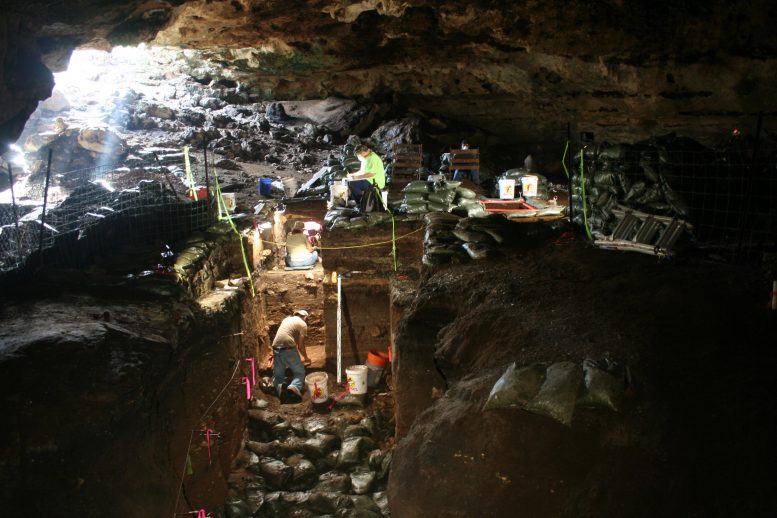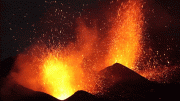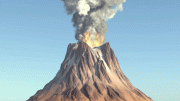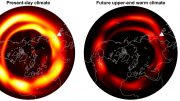
Archaeologic excavations at Hall’s Cave exposed sediments for geochemical analysis that span from circa 20,000 to 6,000 years. Credit: Michael Waters, Texas A&M University
Researchers say cooling 13,000 years ago is coincident with major volcanic eruption.
Texas researchers from the University of Houston, Baylor University, and Texas A&M University have discovered evidence for why the earth cooled dramatically 13,000 years ago, dropping temperatures by about 3 degrees Centigrade (5.4 degrees Fahrenheit).
The evidence is buried in a Central Texas cave, where horizons of sediment have preserved unique geochemical signatures from ancient volcanic eruptions — signatures previously mistaken for extraterrestrial impacts, researchers say.
The resolution to this case of mistaken identity recently was reported in the journal Science Advances.

Steven Forman, Ph.D., Baylor University professor of geosciences. Credit: Robbie Rogers, Baylor University Marketing and Communications
“This work shows that the geochemical signature associated with the cooling event is not unique but occurred four times between 9,000 and 15,000 years ago,” said Alan Brandon, Ph.D., professor of geosciences at University of Houston. “Thus, the trigger for this cooling event didn’t come from space. Prior geochemical evidence for a large meteor exploding in the atmosphere instead reflects a period of major volcanic eruptions.”
After a volcano erupts, the global spread of aerosols reflects incoming solar radiation away from Earth and may lead to global cooling post eruption for one to five years, depending on the size and timescales of the eruption.
The study indicates that the episode of cooling, scientifically known as the Younger Dryas, was caused by numerous coincident Earth-based processes, not an extraterrestrial impact.
“The Younger Dryas, which occurred about 13,000 years ago, disrupted distinct warming at the end of the last ice age,” said co-author Steven Forman, Ph.D., professor of geosciences at Baylor University.
The Earth’s climate may have been at a tipping point at the Younger Dryas, possibly from the ice sheet discharge into the North Atlantic Ocean, enhanced snow cover and powerful volcanic eruptions that may have in combination led to intense Northern Hemisphere cooling, Forman said.

Kenneth Befus, Ph.D., Baylor University volcanologist. Credit: Baylor University Marketing and Communications
“This period of rapid cooling is associated with the extinction of a number of species, including mammoths and mastodons, and coincides with the appearance of early human occupants of the Clovis tradition,” said co-author Michael Waters, Ph.D., director of the Center for the First Americans at Texas A&M University.
University of Houston scientists Brandon and doctoral candidate Nan Sun, lead author, accomplished the isotopic analysis of sediments collected from Hall’s Cave in the Texas Hill Country. The analysis focused on difficult measurements at the parts per trillion on osmium and levels of highly siderophile elements, which include rare elements like iridium, ruthenium, platinum, palladium, and rhenium. The researchers determined the elements in the Texas sediments were not present in the correct relative proportions to have been added by a meteor or asteroid that impacted Earth.
That meant the cooling could not have been caused by an extraterrestrial impact. It had to have been something happening on Earth. But what?
“The signature from the osmium isotope analysis and the relative proportion of the elements matched that previously reported in volcanic gases,” Sun said.
Kenneth Befus, Ph.D., a volcanologist at Baylor University, added that “these signatures were likely the result of major eruptions across the Northern Hemisphere, including volcanoes in the Aleutians, Cascades, and even Europe.”
“I was skeptical. We took every avenue we could to come up with an alternative explanation or even avoid this conclusion,” Brandon said. “A volcanic eruption had been considered one possible explanation but was generally dismissed because there was no associated geochemical fingerprint.”
A volcanic cause for the Younger Dryas is a new, exciting idea, he said. Whether a single major eruption of a volcano could drive the cooling observed, however, is still an open question, the researchers said.
Volcanic eruptions cause their most severe cooling near the source, usually in the year of the eruption, with substantially less cooling in the years after the eruption. The Younger Dryas cooling lasted about 1,200 years, so a sole volcanic eruptive cause is an important initiating factor, but other Earth system changes, such as cooling of the oceans and more snow cover were needed to sustain this colder period, Forman said.
This research underscores that extreme climate variability since the last ice age is attributed to unique Earth-bound drivers rather than extraterrestrial mechanisms. Such insights are important guidance for building better models of past and future climate change.
For more on this research, read Global Cooling 13,000 Years Ago Was Caused by Volcanic Eruptions, Not Meteors.
Reference: “Volcanic origin for Younger Dryas geochemical anomalies ca. 12,900 cal B.P.” by N. Sun, A. D. Brandon, S. L. Forman, M. R. Waters and K. S. Befus, 31 July 2020, Science Advances.
DOI: 10.1126/sciadv.aax8587









The fact is, both senarios could be true.
Meteoric impacts *could* have kick-started a process of ice-cap melting which would shift the weight of that icecap as melt-water drained into oceans. This shift in weight would cause a geological chain reaction, where plates would move in accordance with the weight shift, resulting in earthquakes and volcanic eruptions that would contribute to atmospheric changes made by those impacts.
Why must scientists persistently look at nature with such black and white blinkers? Natural disasters are seldom isolated events but more often a chain reaction of events that lead to a notable outcome.
The evidence uncovered in the Texas cave relates to the general Texas region and until its findings are matched around the globe and all other possibilities eliminated, no absolute conclusions can be drawn as to the any singular cause of global climate disruptions.
There is a long history of academic feuds between geologists championing their particular views. See the following link:
http://historyofgeology.fieldofscience.com/2010/10/granite-controversy-neptunism-vs.html
Typically, what has been found is that neither extreme was right all the time. Sometimes it was one and other times it was the other; sometimes it might even be a mix. It is rare that a particular view or interpretation is universally applicable.
Just because these authors have found evidence for vulcanism doesn’t mean that it is the final word. Vulcanism doesn’t rule out the possibility of a bolide impact. (Some might even argue that the shock of an impact might trigger eruptions.) It, rather, helps explain the duration of the Younger Dryas if there were multiple causes over the 1,200-year period. It appears that the authors have not read Chamberlain’s “Method of Multiple working hypotheses.”
I’ve found many sea turtle fossils in middle tenn. I’ve also found evidence of volcanic activity. Does these findings relate to this 13000 year marker?if so where would that put my region topographical speaking
This article failed to explain the impact spherical deposits also present. One of the major clues to “impact” by meteor or comet. In fact a large impact might also be accompanied by earthquake and yes volcanic eruption.
I’m shocked and amazed that this is not considered. Someone just wanted five minutes of fame perhaps. Okay you got it. Now show me some videos of kittens.
Plato wrote that the gods were angry with the Atlanteans around this same time, which resulted in the Sahara desert (and the ruins underneath it), and many other changes, geological and political.
John the geochemical signatures say no
Instead of commenting about what this brief article doesn’t mention, read the scientific paper that has been published and cited as the source. Many of your issues are answered there.
Something to note is that this is a single location, where the sediments either have to be transported by water, or be small enough to make their way into the cave as a result of very slow settling velocities. The case cannot be made that this single site is representative of the Northern Hemisphere. The site is protected from direct deposition of bolide ejecta. Something else that I didn’t see addressed is that as the limestone is dissolved, silicate impurities of Cretaceous age will make their way to the floor of the cave.
See Martin Sweatman’s of Edinburgh University, pick apart the flaws in this paper in his recent history decoded youtube channel. To state that this one paper studying one cave “upends” over 190 papers now supporting the evidence for many proxies from around the world that point to an impact event is misleading to say the least.
Obviously the sun novas and sheds it’s skin every 12048 years. Due in 2045 next. hence the glass beads that don’t have any bubbles in them found all over earth and same on moon. This article proves it. Good luck.
Guys come on, this is easy: clearly it was volcanoes, a comet, a tsunami, a CME, and aliens. 👽
Just because your find some sediment from a volcanic eruption doesn’t mean you completely dismiss the overwhelming evidence of a meteor hitting our planet… you should really do your research before just trying to post some click bait…. this is the reason we can’t move forward as a society! Look at all possible options everything isn’t black and white.
This story and the research it promotes has was was debunked back in august ..
https://www.youtube.com/watch?v=1gVvblVcKu0
It’s almost laughable…
https://youtu.be/OaC1a7Vfj2I